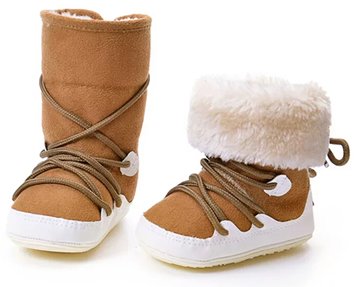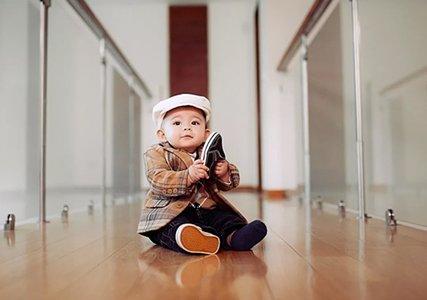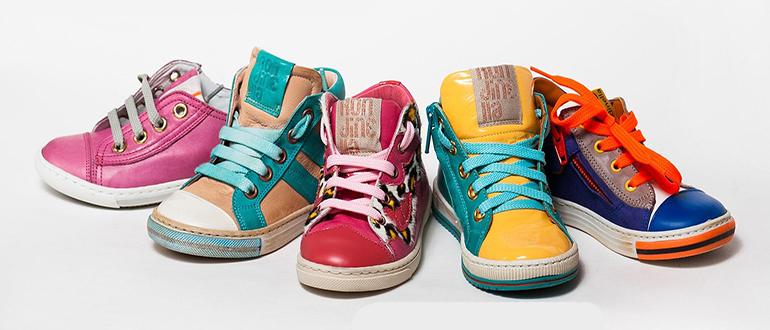The first steps of a baby are incredibly important for every parent. For this reason, many begin to prepare for this stage in advance. The question arises of how to choose the first shoes for the baby so that there are no dire consequences such as flat feet and other problems that appear as the child grows.
Experts note that you really need to have certain knowledge in this matter. We decided to help you answer it so that you don't have to regret making an unsuccessful purchase in the future.
Buying real shoes for a child is a special event for a child, which is accompanied by such nuances as the choice of material, shape, sole, number of fasteners, etc. Each of these moments really should be taken into account. The future health of the baby depends on them, for which adults are responsible.
Content
- 1 The importance of shoes for a child
- 2 List of manufacturers of children's shoes: which companies are better
- 3 Features of sewing shoes for children
- 4 Variety of shoes for a child
- 5 Options for choosing shoes for toddlers
- 6 The choice of material for children's shoes
- 7 Sole and instep support for children's shoes
- 8 Features of the shape of the toe
The importance of shoes for a child

The baby is able to learn to walk without shoes. A person's foot has a certain structure that allows him to move even barefoot. No one is born with boots or children's sandals. If we consider the question of the need for shoes from the point of view of a natural approach, then shoes are not necessary for a child for the first step. But keep in mind, when he learns to move on his feet, you need to teach him to wear shoes. It is not possible to go barefoot to kindergarten, to a doctor's appointment or to a playground.
Parents should be aware that the arch of the foot will remain as it should be in accordance with genetics. Shoes do not have the properties of adjusting it, they are not able to influence the straightness or curvature of the legs. It also has no effect on whether the child walks quickly or slowly. With the help of shoes, you can protect the foot from the cold or mechanical action. But not more. This attribute should be treated this way, and nothing else.
Every child is born with flat feet, in 100% of babies this occurs. The foot will form as the baby's body grows and develops. As a rule, by the age of 12 it becomes clear whether a child suffers from flat feet or not. Experts note that this pathology is often the fault of the parents personally, who taught the child to wear slippers at home and walk in sandals on the street.
The risk of developing the disease can be reduced if the baby is allowed to walk more often without shoes. At home, he should always walk barefoot on the floor. Slippers will be harmful. It is good if there are places where, in addition to the conditions at home, the child can run without shoes. It is good to let him run on the grass, small pebbles, asphalt surfaces. It is much easier for those who live in a private house. You can run barefoot in the yard. All this contributes to the positive formation of the arch of the foot.
You should not be afraid of hypothermia. Parents should not complain that if a child walks barefoot on the floor or on the ground, he will catch a cold.The legs are the part of the human body that have blood vessels; when in contact with a cold surface, they narrow, allowing you to “save” heat without releasing it into the environment. It is very useful to walk barefoot, but sitting on the cold is prohibited - the vessels of the ass do not have such useful properties. Those. from all of the above, it is necessary to conclude that the foot must be healthy, and in order to achieve this, it is worth taking care of it from childhood.
But don't rush things. There is no need to force the child to take the first steps. The musculoskeletal system, ligaments and muscles must be ready for this, in fact, like the feet, the spine. This is especially true for overweight children. Otherwise, there will be problems with orthopedics. The kid should take the first steps consciously, and not by order of adults. As soon as he is ready for this, it will happen.
List of manufacturers of children's shoes: which companies are better

How to choose the first shoe for a child is a concern of many adults. It is incredibly difficult to buy a model that will sit comfortably on your leg, will not rub, and will not unstick after the first bad weather. It is necessary to find a suitable pair for the child, and this is not an easy task, if only because the child is not able to explain whether the legs are comfortable in new sandals.
Moreover, its apparatus of the musculoskeletal system is just beginning the process of formation. The correct development of the child's foot and gait will depend on which shoe will become the one in which he will take the first steps. The question of choosing the first shoe is not trivial. There are many aspects to consider. Not all well-known brands on the market, which are welcomed by orthopedists, collaborate with doctors when they create shoes for children. But there are those who deservedly enjoy a good reputation:
- Minimen;
- Columbia;
- Ecco;
- Flamingo;
- Crocs.
These brands make shoes based on high-quality materials, taking into account the important anatomical features of babies' legs. The very best series of casual and orthopedic footwear for children also need a personal touch.
Features of sewing shoes for children
Please note that the shoes should be comfortable and not overweight. All this will allow the child to move freely in it, not to face discomfort, and to stand firmly on his feet. In this case, it is important that the shoes have a reliable fixation of the foot so that there are no unpleasant injuries. While the child still has poor control over the body, and therefore will often fall down.
The first shoes must meet the following positions:
- the backdrop should be dense and high;
- the toe should be protected and wide;
- the sole is rigid and embossed;
- inner instep support;
- the clasp is comfortable and adjustable. It is desirable so that the baby cannot cope with it on his own.
Children's shoes must be made from natural materials. It can be leather, fur and fabric. At least the area that is in contact with the skin on the leg. It is not necessary that there are nodules on it or convex seams in the area of the inner surface, so that the skin is not rubbed when worn.
Variety of shoes for a child
The division is standard: winter shoes, summer and demi-season. It is recommended to talk about each of them personally, having learned all the pros and cons
Winter shoes for baby

It is quite difficult to take the first step if it snows outside. This is due not only to bad weather, but also by the fact that the models are voluminous, heavy, and the child himself will be clumsy when his parents put on a lot of clothes.
Buying the first pair for subzero weather is justified if the baby is confidently on his feet for winter. Otherwise, there is a chance to wait for warming. You can simply carry the child in felt boots, or limit yourself to sledding or in a stroller.
Keep in mind that the shoes should be very warm without creating a greenhouse effect. To do this, manufacturers knock it out with natural sheepskin or another type of fur.The surface can be covered with natural leather or suede material.
It is better to have high boots that are equipped with long laces. Boots, fabric quilts are also suitable. But keep in mind that the model is equipped with several straps, Velcro. Otherwise, the soft top will not be able to properly fix the leg. A sole with a thick relief is a must. It will help to ensure that the baby's foot does not slip while on the ice.
Benefits
- only natural materials are used in production;
- the outsole is thick and will not slip;
- due to the presence of straps and lacing, you can adjust the shoes on the leg;
- the bootleg is high, and therefore the snow will not get inside;
- shoes for winter have a waterproof upper.
disadvantages
- shoes are heavy, bulky enough, for this reason it is difficult for a child to move around in them;
- not every model is able to fix the ankle perfectly.
Summer shoes for toddler

Summer is the best time to walk confidently down the street. The child needs to buy a pair of shoes that are light, moderately open and breathable. These can be sneakers with a mesh upper or sandals. The ankle will securely fix the leg, and the fingers and heel will be protected.
It is allowed to use sandals that have a half-open toe. In such models, the leg will not sweat, and unpleasant injuries will not be dangerous.
Benefits
- very beautiful and bright models are offered on the market;
- the weight of the shoe is small;
- ventilation of the legs is good enough;
- you can easily choose the size;
- adjustable rise with the help of Velcro.
disadvantages
- suitable only for 1 season;
- the fabric will fade quickly.
Demi-season shoes for babies

Such shoes are suitable for wearing in autumn and spring. It has a closed cut, is often presented with a thickened sole and has a knitted, fleece insulation inside. It can be shoes, low shoes, leather sneakers. It is imperative that the models are stitched and glued to prevent the baby from getting his feet wet.
Fall shoes are perfect for the first steps. Its design meets all the necessary requirements that make it possible to protect the child's fragile legs.
Benefits
- models are warm, you can walk in them even in autumn;
- will not get wet or blown out;
- the leg is fixed from different sides;
- the sole is stiff and embossed. There are models with a raised nose, which perfectly protect the feet and toes;
- easy to clean.
disadvantages
- the shoes are of high quality, they are sewn only from natural leather material, and therefore the price for them is high;
- models can be presented without adjusting the lift, as well as completeness, and therefore it becomes difficult to select a suitable size.
Options for choosing shoes for toddlers
Shoe sizes

Initially, you need to decide on the size of the child's feet. To do this, take a sheet of A4 paper, put the child on top and use a ballpoint pen to circle his leg. Then use a centimeter to determine the size. Add 0.5-1 cm to it. You can cut out a template and go shopping with it to a shoe store. With this life hack, you can buy the right pair.
In order not to look blindly for shoes, study the sizes of the American and European systems. If the foot is 10-10.5 centimeters long, then it is 17-18 sizes in Europe and 2.5-3.5 US.
But from 10.5-11.7 centimeters - 19 size within the Euroline and 4-4.5 in the United States. More than 11.7-12.5 centimeters - 20 and 5-5.5, respectively. Please note that children grow up very quickly, and therefore parents should not be lazy after walking on the street - to examine the baby's legs. If there is redness in places where there was contact with the shoes, you need to go for a second pair, where the size will be larger.
Do not buy a model that is too large, otherwise it will not hold your foot properly. The deviation from the actual size should not be more than 1 centimeter.
The choice of material for children's shoes
Modern manufacturers most often use natural materials. But there is also room for artificial ones. These are suede, fur, felt, cotton, leather, nubuck, etc. Of course, a pair is unlikely to be completely worn out by a child, but you should not save on quality. It is better to give preference to a model where there is no synthetics in general.
The optimal solution is leather. The material fits snugly to the baby's leg, making it possible to provide excellent fixation. At the same time, the skin is elastic enough, and therefore it will not rub on the heels or fingers.
If you need a model for the summer, choose a thick fabric that also won't press, has an excellent ability to "breathe", and it will hold the leg well. The clasps in such variants are weak.
To choose boots for the winter, you need to arm yourself with such criteria. Pay attention to what type of insulation was used by the manufacturer. Maybe a membrane, thinsulate, sheepskin. The first option is suitable for wet winters that are not harsh. But Thinsulate has high water resistance rates. He is able to perfectly warm, even if severe frosts come.
As a sheepskin, an ideal option is presented, which is able to give the baby's legs thermoregulation, allowing them to "breathe".
Sole and instep support for children's shoes

When a child is just learning to walk, he needs support under his feet. For this reason, it is better to give preference to models with a raised sole that will not slip. Flexibility is equally important. But keep in mind that this applies not only to the midfoot. In the area of the edges, maximum rigidity is also needed.
Pay attention to whether there is a heel. It should be in the form of a thickening of the sole, creating a height difference between the heel and toe of 5-7 mm. It is important that the child's first pair of shoes have an instep support. It is a small soft bump on the insole, which is arranged on the inside of the foot. It will provide additional support for the arch of the foot, not allowing to reduce the load in the heel and toe area, and prevents the development of such an ailment as flat feet.
Features of the shape of the toe

Choose shoes that have a round closed toe. It is better if in the area above the fingers there was a free space in the region of a couple of millimeters. Due to this, the child will feel more comfortable, because he still needs to get used to shoes. At the same time, his legs will be protected from injuries and blows.
If this is a summer shoe, the toecap still needs to provide protective options. It can be half-closed so that there is ventilation on one side of the leg, but at the same time it will not allow the toes to slip forward.
An open toe must be discarded. One-year-old children stand uncertainly on their feet, and therefore they often fall, even if the surface excludes pits and irregularities. So an open toe is not suitable.



